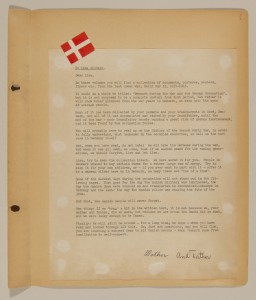<< Previous | Displaying results 1626-1650 of 6705 for "" | Next >>
-
Julian Noga's prisoner uniform jacket
ArtifactA blue and gray striped jacket from the Flossenbürg concentration camp. The letter "P" on the left front of the jacket indicates that it was worn by a Polish, non-Jewish prisoner. "P" stands for "Pole" in German. The jacket was donated to the United States Holocaust Memorial Museum by the prisoner who wore it, Julian Noga.
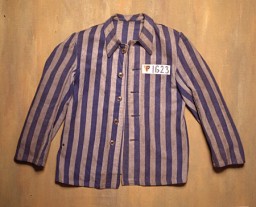
-
Hana Mueller's concentration camp skirt
ArtifactHana Mueller altered this skirt issued to her in the Auschwitz concentration camp in 1944 by using the hem to make pockets.

-
Knife made by Yona Wygocka Dickmann
ArtifactYona Wygocka Dickmann fashioned this jackknife from aluminum and part of a saw after the SS transferred her from Auschwitz to forced labor at an airplane factory in Freiburg, Germany, in November 1944. She used the knife to extend her daily ration of bread by cutting it in half.
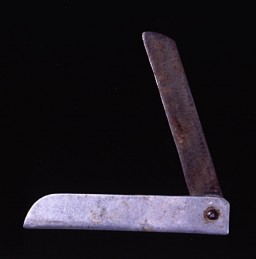
-
Granite quarried in Mauthausen
ArtifactThis photograph shows some of the 190 granite blocks donated to the United States Holocaust Memorial Museum by the Mauthausen Public Memorial in Austria. The Nazis established the Mauthausen concentration camp in 1938 near an abandoned stone quarry. Prisoners were forced to carry these granite blocks up more than 180 steps. The small blocks weighed between 30 and 45 pounds each. The larger blocks could each weigh more than 75 pounds. Prisoners assigned to forced labor in the camp quarry were quickly worked…
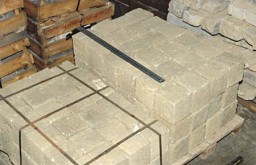
-
Casting of Majdanek gas chamber door
ArtifactThis casting of a gas chamber door in the Majdanek camp, near Lublin, Poland, was commissioned by the United States Holocaust Memorial Museum. Each gas chamber in Majdanek was fitted with an airtight metal door and was bolted shut before gas entered the chamber inside. SS guards could observe the killing process through peepholes in the upper center of the door.
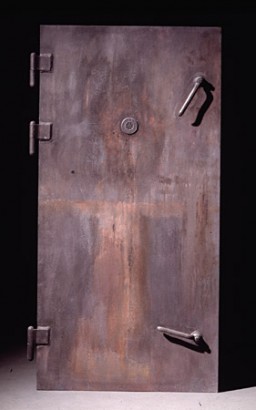
-
Romani (Gypsy) woman's skirt
ArtifactThis taffeta and cotton skirt dates from the 1920s. It belonged to a Romani (Gypsy) woman who was born in Frankfurt, Germany, and who lived in Germany before the war. She was arrested by the Nazis and interned in the Auschwitz, Ravensbrück, Mauthausen, and Bergen-Belsen camps. She died in Bergen-Belsen in March 1945, shortly before the camp's liberation. Her husband and two of her six children were also killed in the camps.
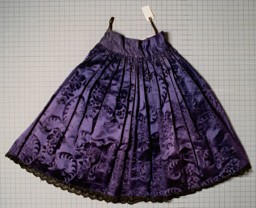
-
Religious articles found on death march victim
ArtifactSet of tefillin in an embroidered bag. Tefillin are ritual objects worn by religious Jews during weekday morning prayers. This set was found on the body of a death march victim, who was buried near Regensburg, Germany.

-
Bible found at liberation
ArtifactSoviet forces liberated the Sachsenhausen concentration camp in April 1945. In the camp, Soviet soldiers found this German edition of the Old and New Testaments on a dead prisoner, a Jehovah's Witness. The bible was sent to the prisoner's surviving family members.
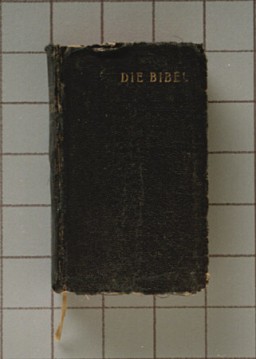
-
Matchbox cover with Japanese propaganda illustration
ArtifactDuring the war the Japanese flooded Shanghai with anti-American and anti-British propaganda, including this image from a matchbox cover. It depicts a Japanese plane dropping a bomb on the U.S. and British flags. Shanghai, China, between 1943 and 1945. [From the USHMM special exhibition Flight and Rescue.]
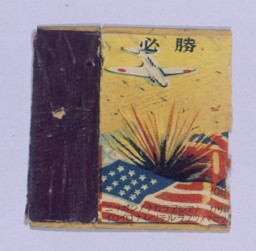
-
Matchbox cover with Japanese propaganda illustration
ArtifactDuring the war the Japanese flooded Shanghai with anti-American and anti-British propaganda, including this image from a matchbox cover. It depicts Japanese planes flying in formation over the U.S. and British flags, with the Japanese flag rising in triumph. Shanghai, China, between 1943 and 1945. [From the USHMM special exhibition Flight and Rescue.]
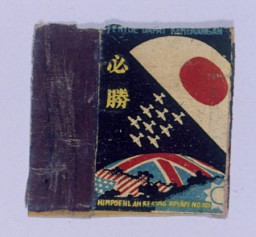
-
Matchbox cover with Japanese propaganda illustration
ArtifactDuring the war the Japanese flooded Shanghai with anti-American and anti-British propaganda, including this image from a matchbox cover. It depicts a Japanese tank rolling over the U.S. and British flags. Shanghai, China, between 1943 and 1945. [From the USHMM special exhibition Flight and Rescue.]
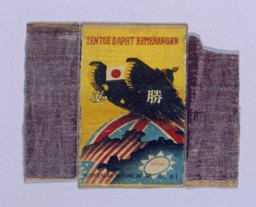
-
Matchbox cover with Japanese propaganda illustration
ArtifactDuring the war the Japanese flooded Shanghai with anti-American and anti-British propaganda, including this image from a matchbox cover. It depicts United States President Franklin D. Roosevelt--dressed in rags, on a raft in the ocean, and holding onto the U.S. flag--in the view of a Japanese submarine periscope. Shanghai, China, between 1943 and 1945. [From the USHMM special exhibition Flight and Rescue.]

-
Matchbox cover with Japanese propaganda illustration
ArtifactDuring the war the Japanese flooded Shanghai with anti-American and anti-British propaganda, including this image from a matchbox cover. It depicts a Japanese bomb landing in the United States heartland and knocking the stars off the U.S. flag. Shanghai, China, between 1943 and 1945. [From the USHMM special exhibition Flight and Rescue.]
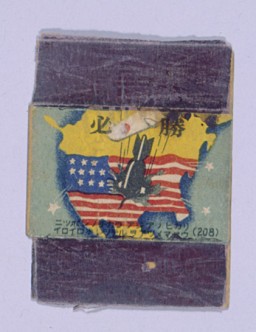
-

-
Sign excluding Jews from public places
ArtifactSigns excluding Jews, such as the sign shown here, were posted in public places (including parks, theaters, movie houses, and restaurants) throughout Nazi Germany. This sign states in German: "Jews are not wanted here."

-
Hotel Reichshof flyer
Artifact1939 flyer from the Hotel Reichshof in Hamburg, Germany. The red tag informed Jewish guests of the hotel that they were not permitted in the hotel restaurant, bar, or in the reception rooms. The hotel management required Jewish guests to take their meals in their rooms. Following the Nuremberg Laws of 1935, Jews were systematically excluded from public places in Germany.
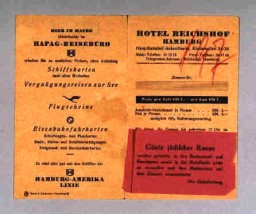
-
Antisemitic children's book
ArtifactAntisemitic children's book published in 1936 in Nuremberg, Germany. The title, in German, is translated as "You Can't Trust a Fox in the Heath and a Jew on his Oath: A Picture Book for Young and Old." The cover depicts a fox in the heath and a caricature of a Jew taking an oath.
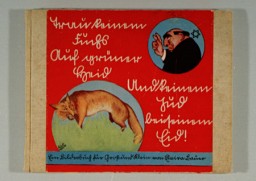
-
Comb made by Yona Wygocka Dickmann
ArtifactYona Wygocka Dickmann fashioned this aluminum comb from airplane parts after the SS transferred her from Auschwitz to forced labor in an airplane factory in Freiburg, Germany, in November 1944. She used the comb as her hair, shaven in Auschwitz, began to grow back.
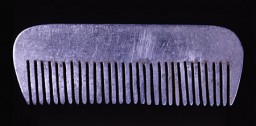
-
Desecrated Torah scrolls
ArtifactThese Torah scrolls, one from a synagogue in Vienna and the other from Marburg, were desecrated during Kristallnacht (the "Night of Broken Glass"), the violent anti-Jewish pogrom of November 9 and 10, 1938. The pogrom occurred throughout Germany, which by then included both Austria and the Sudetenland region of Czechoslovakia. The scrolls pictured here were retrieved by German individuals and safeguarded until after the war.
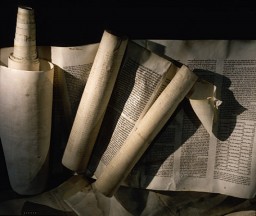
-
Pages of Hebrew prayer books damaged during Kristallnacht
ArtifactThe pages photographed here are from Hebrew prayer books destroyed during the Kristallnacht ("Night of Broken Glass") pogrom of November 9 and 10, 1938. These pages were damaged by fire during the destruction of the synagogue in Bobenhausen, Germany. The Jewish community of Giessen donated them to the United States Holocaust Memorial Museum in 1989.
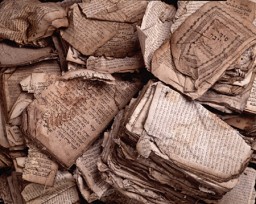
-
Bible from Le Chambon pastor who saved Jews
ArtifactThe family bible shown here belonged to Andre Trocme and contains annotations he made in preparation for his sermons. Trocme was a Protestant pastor in Le Chambon-sur-Lignon, France. During the war, he and the town's residents helped shield Jews, especially Jewish children, and others from the Germans. The operation saved thousands of refugees, including about 5,000 Jews. His handwritten inscription in French reads, in part, "Happy are those hungry and thirsty of justice; for they will be satisfied."
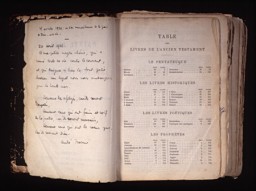
-
Buchenwald trial document
ArtifactDocument from the Buchenwald trial stating that both the prosecution and the defense teams agree to waive their right to make closing statements. The document is signed by the US military prosecutors (including William Denson), the defense lawyers, and the defendants. Dachau, Germany, August 8, 1947.
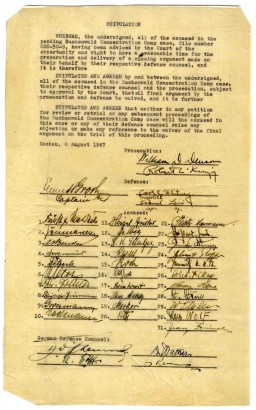
-
Election poster
ArtifactThis election poster calls on Germans to vote in support of Hitler's hand-picked candidates to the Reichstag (the German parliament). The poster details Hitler's actions and reads, in part: 'In 8 months two and a quarter million Germans have work and bread again! Class warfare and its parties are eliminated! The Bolsheviks are smashed. Particularism is overcome! A Reich of order and cleanliness is established. One People. One Reich. One Leader. This is what Hitler has accomplished..."

-

-
Dedication to a set of scrapbooks documenting the German occupation of Denmark
ArtifactDedication to a set of scrapbooks compiled by Bjorn Sibbern, a Danish policeman and resistance member, documenting the German occupation of Denmark. Bjorn's wife Tove was also active in the Danish resistance. After World War II, Bjorn and Tove moved to Canada and later settled in California, where Bjorn compiled five scrapbooks dedicated to the Sibbern's daughter, Lisa. The books are fully annotated in English and contain photographs, documents and three-dimensional artifacts documenting all aspects of the…
